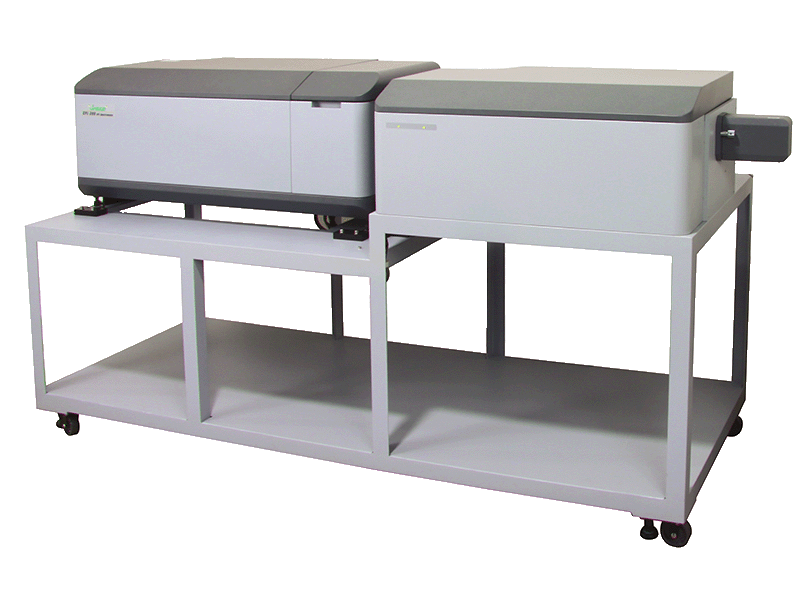The CPL-300 uses the original 180° fluorescence collection approach proposed by Steinberg. The standard ozone-free 150W Xe lamp can be user-replaced with an Hg/Xe source. The instrument’s double prism excitation and emission monochromator delivers very low stray light and no spurious linear polarization effects caused by diffraction gratings.
Circularly polarized luminescence (CPL) offers complementary information to other chiroptical techniques such as Optical Rotatory Dispersion (ORD), Circular Dichroism (CD) and Vibrational Circular Dichroism (VCD).

Chiral properties of molecules in both liquid and solid states can differ greatly. Many of the devices used in today’s advanced technological fields of research are based on circularly polarized light-emitting molecules. CPL is an ideal technique for use with these solid-state samples.
The CPL-300’s unique 180° linear optical design provides pure, unpolarized excitation light allowing the elimination of artifacts due to fluorescence anisotropy. Samples such as KBr pellets and PMMA films are easily measured providing highly reliable CPL spectra). CPL measurements on samples with known macroscopic anisotropy such as single crystals are routinely reported in literature using a dedicated CPL spectrometer.
In addition, measurements on solid-state samples are being reported today using the JASCO CPL-300 Spectrometer.
A CPL signal is the intensity difference between left and right circularly polarized light emitted by a chiral molecule which is excited with unpolarized light. The circularly polarized luminescence spectrophotometer supplements the information obtained from other chiroptical techniques such as electronic or vibrational circular dichroism.
Circular dichroism (CD) spectroscopy is widely used in the study of optically active substances. CD spectroscopy provides information about the structure of optically active substances in the electronic ground state, however, CPL spectroscopy provides information about excited states. The two techniques are therefore complimentary.
Materials that exhibit circularly polarized luminescence are being actively investigated in applications such as liquid crystal display backlights, 3D displays, holographic displays, light sources for controlling plant growth, and security systems for optical communications and printing.
It is therefore important to identify molecules that emit one-handed circularly polarized light with high quantum yield. CPL spectra contain important information such as the stable structure of excited molecules, and the behavior of these molecules in chemical reactions that involve an intermediate excited state. However, fluorescence emission is generally weak and CPL signals are even weaker, making it difficult to detect. The CPL-300 offers high sensitivity for detection of these weak signals over a wide spectral range.
Download CPL-300 Resources
©Jasco Europe S.R.L. (Socio Unico) Direzione e coordinamento ex. art. 2497 bis c.c. – P.I. 08609570158 | Privacy Policy | Cookie Policy | Manage consent | Realizzazione sito web: Alkimedia
to download your PDF Books or Brochures.
| Cookie | Duration | Description |
|---|---|---|
| cookielawinfo-checbox-analytics | 11 months | This cookie is set by GDPR Cookie Consent plugin. The cookie is used to store the user consent for the cookies in the category "Analytics". |
| cookielawinfo-checkbox-necessary | 11 months | This cookie is set by GDPR Cookie Consent plugin. The cookies is used to store the user consent for the cookies in the category "Necessary". |
| CookieLawInfoConsent | 1 year | Records the default button state of the corresponding category & the status of CCPA. It works only in coordination with the primary cookie. |
| elementor | never | This cookie is used by the website's WordPress theme. It allows the website owner to implement or change the website's content in real-time. |
| viewed_cookie_policy | 11 months | The cookie is set by the GDPR Cookie Consent plugin and is used to store whether or not user has consented to the use of cookies. It does not store any personal data. |
| Cookie | Duration | Description |
|---|---|---|
| Google Maps | Google Maps is a map visualization service managed by Google Inc. and is used to integrate such contents within its pages. |